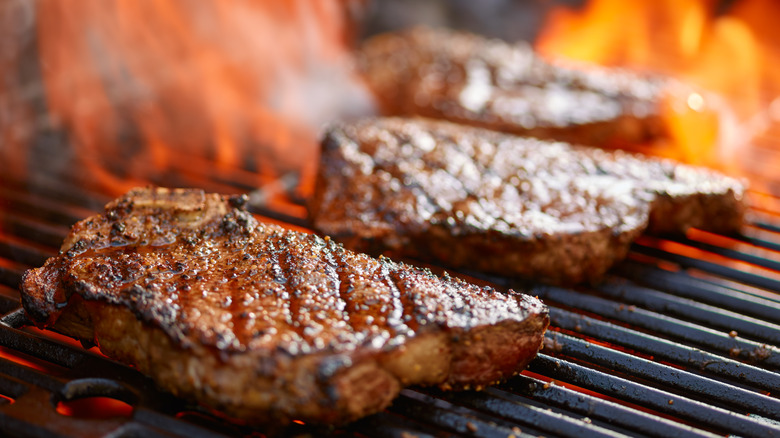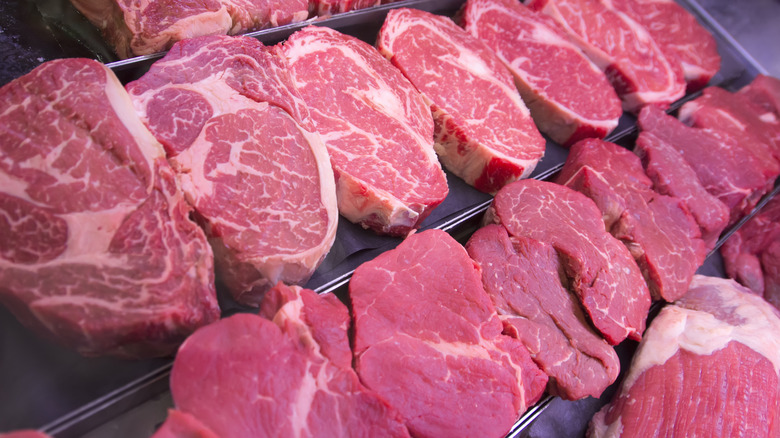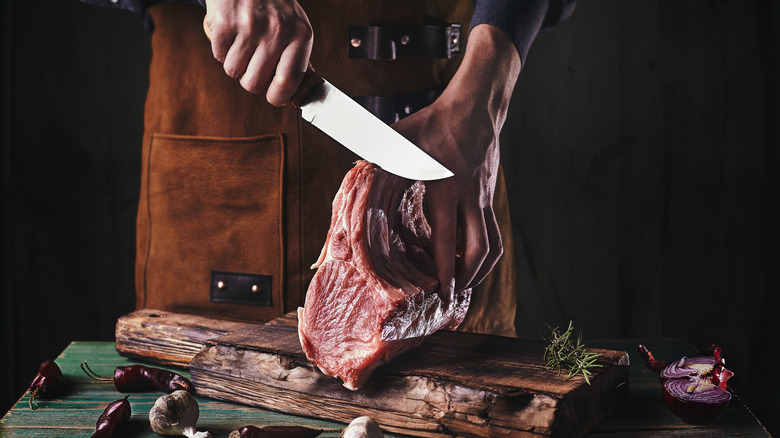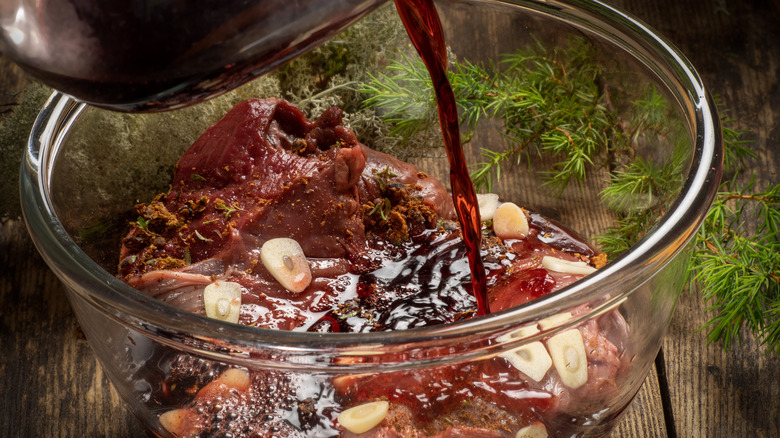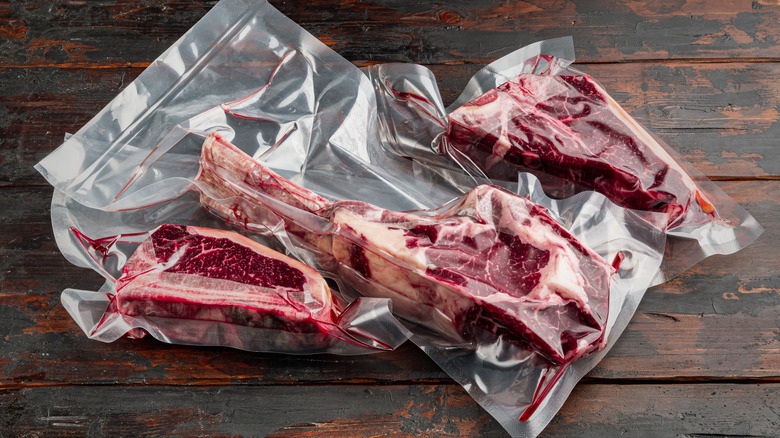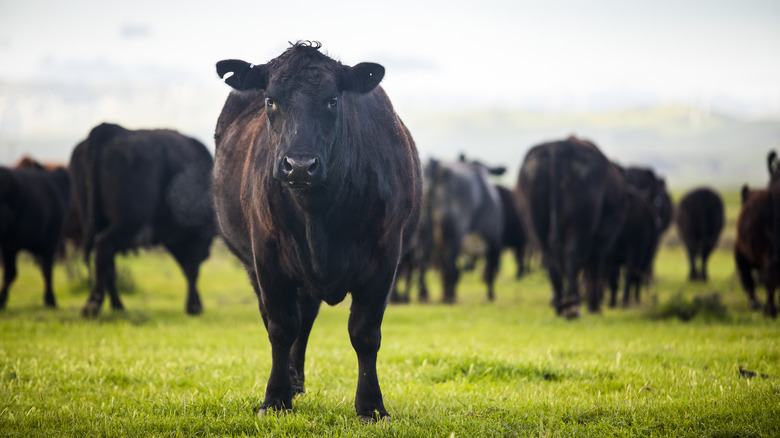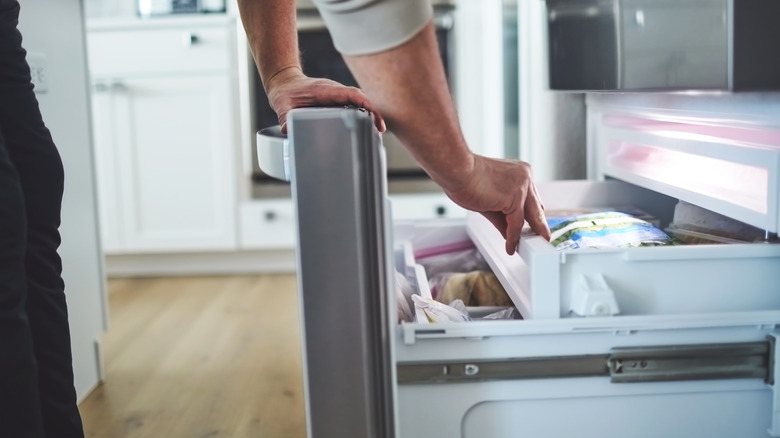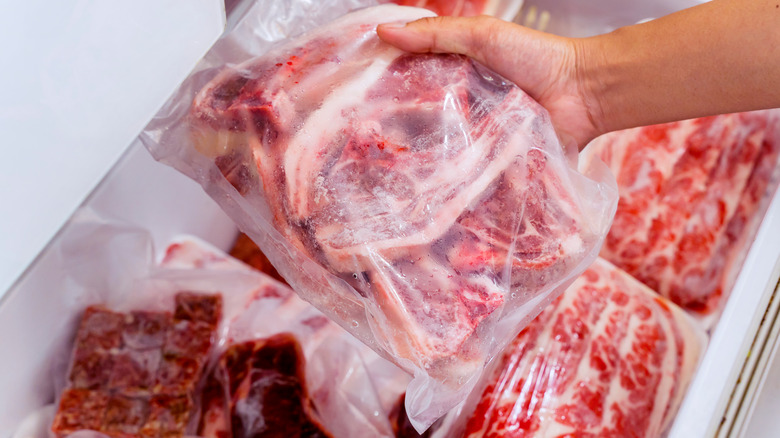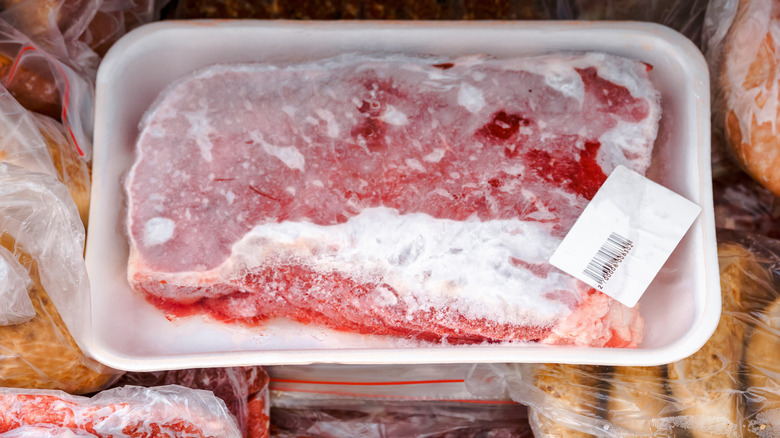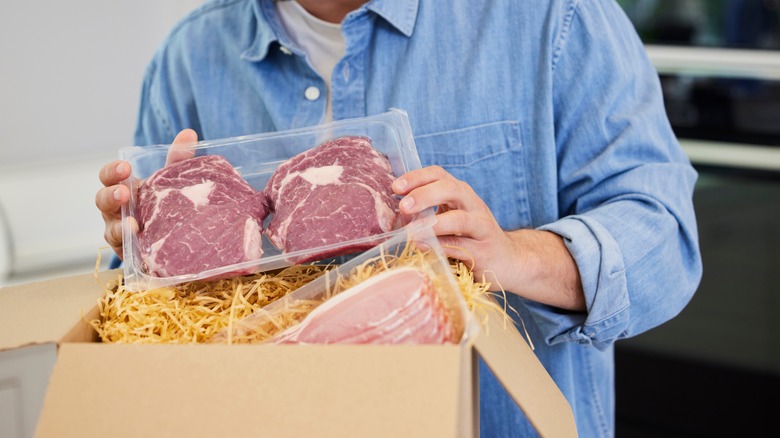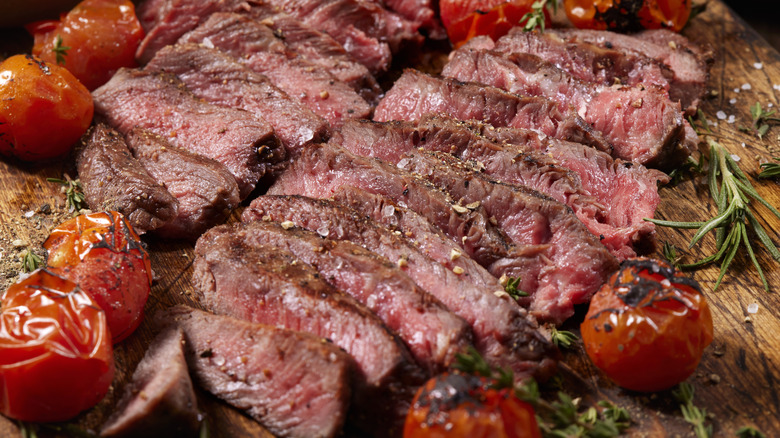Tips For Buying Steaks In Bulk
If you've never thought of buying steaks in bulk before, you may be missing out. When you buy steaks in bulk, you can stock up whenever prices are best. Then, you always have steak on hand in the event you have a sudden craving for steak and eggs in the middle of the night or if some surprise guests show up on your doorstep and you need to cook up a quick meal that will impress. Plus, sometimes it just makes sense to buy steak in bulk if you're hosting an event, whether it's a backyard barbecue that calls for some T-bones on the grill or a holiday dinner that necessitates prime rib with all the sides.
However, don't just buy a bunch of steaks; toss them in your freezer, and assume you'll both save money and be able to enjoy like-fresh steaks any time at all for the next year. You'll need to follow our tips and tricks to ensure your bulk steak stays as high quality and delicious as it was the day you bought it at the best price possible. For example, did you know that you shouldn't freeze marinated steak, as it doesn't hold up as well? Or that you can get better deals on steaks if you buy a large cut of beef and do a little butchering on your own at home? Keep reading to find out more, plus other ways to get the most out of your next bulk steak purchase.
Look for steaks of similar sizes
If you plan on cooking all your bulk steak at one time, like for an event, you need to look for steaks of similar sizes at the grocery store. If you have steaks of all different shapes, widths, and circumferences — even if they're technically the same cut — you'll end up having to do a lot of math and juggling to ensure you're cooking each steak to the appropriate doneness based on cooking times relative to sizes. (Otherwise, you'll just have a bunch of steaks with wildly varying levels of doneness, some potentially rare and others burned to a crisp.)
To make cooking your multitude of steaks as easy as possible, try to purchase one-inch steaks all around. Typically, a one-inch steak will require about 10 minutes of total cooking (cooking on both sides combined) to be considered rare; about 14 minutes of total cooking for medium-rare; about 20 minutes of total cooking to be medium; about 24 minutes of total cooking to be medium-well; and about 30 minutes of total cooking for well done. Regardless of how long you cook your steaks, always let them rest for 5–10 minutes before cutting and serving. The rest time is important as it allows the meat to finish cooking. Plus, if you don't let cooked meats rest and cut right into them, you're more likely to end up with a dry steak, as the juices aren't able to be redistributed throughout the entire piece of meat.
Break down larger cuts of meat at home
Often, you can get a better deal on a meat purchase if you buy that meat in larger quantities. However, this doesn't just apply to buying individual cuts of meat in bulk. You can also, even more often, save money by purchasing larger cuts of meat and then breaking them down into smaller, individual cuts on your own at home. (For example, you'll nearly always find buying a whole chicken to be more affordable than purchasing individual pieces.)
When it comes to steak, your larger cuts will be limited in the grocery store, at least compared to what you could buy if you purchased beef directly from a farm. However, you can still find a few select large pieces that can be broken down into smaller pieces, like a beef tenderloin. When sliced into medallions, this long cut of meat transforms into delicious filet mignon. On average, if you have a five-pound loin, you can turn it into six filet mignon steaks. If you can get your hands on an even larger cut, like a beef striploin, you can turn that into a New York strip; a 14-pound striploin produces about 10 New York strip steaks. To break down large cuts at home, you won't necessarily need any fancy kitchen equipment; you can break down strips and tenderloins using a sharp knife that's 8 to 10 inches long. You'll also want a cutting board, ideally large enough to safely hold the loin.
Don't buy pre-seasoned steaks
If you're not cooking your bulk number of steaks right away and need to save some for later, don't buy pre-seasoned steaks (you've likely seen the type — they're usually vacuum-sealed and covered in a marinade and lots of visible herbs and spices). While, if cooked quickly, marinades and seasonings can turn a steak into a totally tender and deliciously flavored entrée, if left for a while, the marinade can do your steak more harm than good.
According to the U.S. Department of Agriculture, marinades begin to negatively impact the quality of meat after just two days, as the marinade essentially begins eating away at the meat texture. This is because marinades typically contain an acid, like vinegar or citrus juice, and acids "denature" proteins (denaturing is basically just a fancy term for breaking down protein strands). As the protein strands break down under the acid's influence, the meat not only becomes more tender, but also more flavorful, as your marinade can access more surface area of the meat thanks to that deteriorating protein. However, let this process go on too long, and things turn bad. The meat becomes mushy and mealy, as one bulk steak purchaser on Reddit can attest. If you want to marinate your steak, do it when you're thawing it, allowing the frozen steak to thaw in the marinade for up to 24 hours, but no longer.
Invest in a vacuum sealer
What if you want to stock up on steak long-term? If you're going to buy enough steak to last you for months or even years to come, you'll want to be strategic. As the U.S. Department of Agriculture notes, steak can only be safely stored in the refrigerator for up to five days. For optimal freshness and quality, steaks should only be frozen for up to a year. However, if you invest in a vacuum sealer, your food can last quite a bit longer.
According to FoodSaver, properly vacuum-sealed steaks can safely remain in your freezer for up to three years. That said, there are still some things you'll want to watch out for when cooking three-year-old, vacuum-sealed steaks because they can still go bad under the right circumstances. Signs that a vacuum-sealed steak is no longer safe to eat include a slimy coating, weird smell, or "off" color. Additionally, if the steak was not correctly vacuum sealed, it may show signs of freezer burn about a month after you sealed it.
Go direct to the farmer
While it's certainly possible to buy steak in bulk at your local grocery store, if you want to purchase more than your grocery store has in stock or if you want specific or larger cuts that your grocery store doesn't carry, you may want to go direct to a local farmer. Doing so comes with a range of benefits.
First and foremost are the cost savings (think buying wholesale versus retail). However, if there are multiple farms in your region that offer the option to buy your beef directly from them, you'll be able to pick and choose the farm that aligns with your values (such as if you prefer grass-fed, pastured-fed, etc.). Additionally, some farmers will allow you to directly choose how the meat is processed, in case you want specific cuts or cuts of certain sizes. While you might not be able to buy steak and only steak in bulk under these circumstances, you do get a lot of steaks, along with ground beef, roasts, and other cuts.
Know your freezer
No matter how you buy your bulk steak, ensure you know how much your freezer can hold before you make that purchase. Don't just "guesstimate" or eyeball your freezer space and assume that you can fit it all in. Additionally, keep in mind that you won't be storing steak and steak alone in your freezer. You'll need extra room for any other purchases you make or frozen foods you routinely prep for later use.
What's a safe way to know how much beef your freezer can hold? According to Oklahoma State University, you can expect to store 35 to 40 pounds of packaged beef in every single cubic foot of freezer space. A chest freezer offers anywhere from 3 to 17-plus cubic feet of space, depending on the freezer's size. However, most households don't own a chest freezer and rely on whatever small freezer space is built into their fridge. To measure your freezer space in cubic feet, measure the freezer depth, height, and width in feet and multiply the numbers to get your total.
Add an extra air-tight layer
Yes, you can freeze steaks for up to 12 months, according to the U.S. Department of Agriculture, and yes, if you invest in a food vacuum sealer, you can potentially store your frozen steaks for up to three years without noticing a deterioration in quality, according to food vacuum sealer brand FoodSaver. However, if you're not using a vacuum sealer and want to store your bulk steaks for longer than two months while maintaining a decent quality, the U.S. Food & Drug Administration recommends taking some extra precautions.
The FDA notes that if you want to leave the steaks in their original packaging from the store, you should add another layer of packing, just in case. This extra exterior layer should be airtight, and the FDA recommends using a plastic bag, heavy-duty aluminum foil, freezer paper, or plastic wrap. The USDA further notes that an extra layer of protection like this is necessary because the store's packaging is typically thin and does let in at least a little air, which may cause freezer burn.
Label your steak before storing
Even if you store your bulk steak in a freezer bag or vacuum-sealed bag that's clear, it can become pretty difficult to distinguish one piece of frozen meat from another after a few months. Sure, you know it's a steak, but there's a lot more you need to know when rooting around in the freezer for the perfect item to thaw.
According to the National Center for Home Food Preservation, whenever storing a food item in your freezer long-term, use freezer-safe labels or freezer tape, as well as a writing utensil that won't easily smudge, and record what the item is, whether or not you added anything to the item before storing (like if you added seasonings or marinades to the steak — which you should only do if you plan on eating the steak within a few days), how many servings are included, and, of course, when you repackaged and froze it.
If you're using a permanent marker, be sure to label each packaged cut before you freeze it, ideally while it's close to room temperature. Excessive temperatures can impact ink's integrity and leave you with a smudged mess (at best now, and at worst, months from now when you're trying to decipher what's lurking in the back of the deep freeze). If you freeze your steak in reusable plastic or glass containers, don't skip labeling; you can still write right on the container and erase your note using rubbing alcohol once no longer needed.
Look online
If you can't find the steak you want in bulk quantities at the store, look online. You can find a range of retailers that offer to ship bulk quantities of steak (and other meats) right to your door. Some are wholesalers that primarily sell to restaurants (but not exclusively), some offer subscriptions, and some allow you to buy a portion of a cow directly from a farmer.
If you do order bulk steak online, make sure you're ready and waiting for it when it arrives. Most meat is shipped vacuum-sealed, already frozen, and in insulated packaging, along with freezer packs or dry ice. If your meat was shipped using dry ice, remove the ice and allow it to evaporate. You don't want to touch it directly (move it with some tongs or an oven mitt), and don't let your kids or pets around it. Then, transfer the steaks directly to the freezer, unless you plan on eating some of them in the next 24 hours.
Stock up on cheap cuts
Many shoppers who stock up on bulk quantities of steak are doing so because they want to save money. One way you can easily save even more money is by stocking up on cheaper cuts of steak that are particularly good for serving a crowd. While prime rib or filet mignon may be your favorite and what you cook when you want a nice meal, they're not exactly cost-effective for feeding the entire family at a barbecue or over the holidays.
Instead of pricier cuts, for occasions like these, consider going with larger strip steaks that you can further break down for more servings per steak; flat iron steaks that are good for grilling; or sirloin or flank steaks that can be broken down for recipes that require smaller portions of cubed steak. Particularly when cooking bulk steak for a crowd, if you're trying to go as budget-friendly as possible, look for recipes that can make your steak go further, such as steak salads, kebabs, or fajitas.
Don't stock up while the weather is iffy
Imagine it. You've stocked up on your favorite cuts of steak. Your freezer is packed. You're set for months and months of amazing steak dinners — and then the power goes out, your freezer shuts off, and all that steak goes to waste. While we can't always predict a power outage, if you live somewhere where power outages are frequent during certain parts of the year (such as during hurricane season or wildfire season), you may want to hold off on stocking up on steak until you're no longer at risk.
If it's too late and you did stock up on steak, and your power goes out, you have limited time to save your steak. According to FoodSafety.gov, a freezer can safely hold food during a power outage for up to 48 hours; however, that amount of time decreases the more food is in your freezer and the more times you open the freezer door.
Know the signs of a bad steak
No matter how long you keep your bulk steak in the freezer, it's always smart to know the signs of a steak gone bad. Once thawed, a spoiled steak may have a slimy, gross layer on top and smell slightly like ammonia or eggs. All of this can make for a steak dinner that smells and tastes quite unpleasant, leaving a lot to be desired, texture-wise. The U.S. Department of Agriculture notes that spoilage bacteria on food isn't likely to make you ill. Instead, you're much more likely to become sick due to pathogenic bacteria, the USDA clarifies, which grow on food when it sits for an extended amount of time at a temperature between 40 degrees Fahrenheit and 140 degrees Fahrenheit.
If you suspect you have food poisoning from affected steak, you can treat your symptoms at home by waiting them out, staying hydrated, and avoiding any foods or substances that might further irritate your gastrointestinal system. If symptoms have not improved within 48 hours, a primary care provider may treat you with probiotics, antibiotics, or other measures to prevent severe dehydration.
